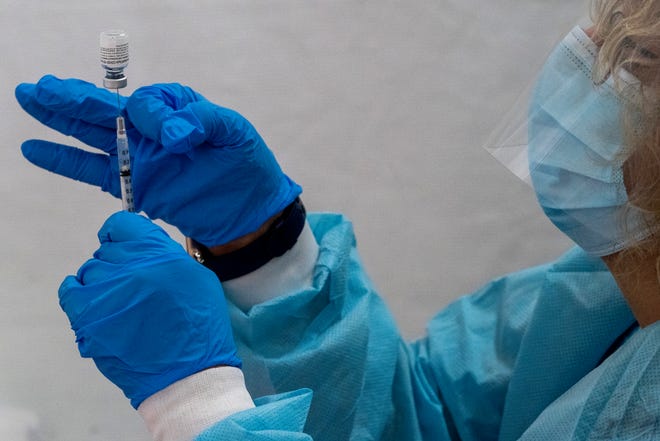
One year ago, the novel coronavirus upended our lives. Before we were able to reliably track the virus, the pandemic smashed through hospitals in Wuhan, Lombardy and New York City, leaving families grieving and healthcare workers devastated. The staggering intensity of those early days should haunt us all.
In an eerie deja vu, we are now facing several new SARS-CoV2 variants of concern that have overwhelmed hospitals in the United Kingdom, South Africa, and Brazil. As in spring 2020, we are again caught on our back foot, with little infrastructure in place to catch or characterize these new strains. These variants will not be the last to emerge, just as the novel coronavirus will not be the last pathogen to threaten the national security of the United States.
Testing and Genomic surveillance
The Biden-Harris administration has requested billions of dollars to fight the pandemic in the American Rescue Plan. The request includes funding for testing, genomic surveillance and outbreak analytics. Each plays an important role in turning the tide against COVID-19, and those investments can provide a foundation for better preparedness.
The American Rescue Plan requests $50 billion for the testing needed to find cases and break chains of transmission. As vaccine coverage expands and community prevalence falls, so too will demand for diagnostic testing. Yet, even as vaccines roll out, diagnostic testing will remain a critical tool for fighting the pandemic. The vaccines are not authorized for kids under 16, and vaccine hesitancy will keep pockets of people from getting the protective shots. Meanwhile, reduced demand for diagnostic testing will free up capacity to expand once or twice weekly screening testing in high risk settings like prisons and jails, schools and congregate living facilities.

The two-pronged testing strategy — diagnostics and screening — should become the playbook for responding to pandemics. Maintaining testing capabilities will be critical for responding to the next pandemic. In the meantime, this base will be exceptionally useful to fight seasonal influenza, which causes millions of cases and tens of thousands of deaths in the U.S. each year.
The United Kingdom sequences around 8% of their COVID-19 cases to monitor changes in viral evolution and identify new variants. This practice allowed them to observe that one variant, B117, had edged out others and precipitated a severe winter wave. In contrast, the United States sequences less than 1% of cases and has little in the way of coordinated genomic surveillance, making such insights impossible. That will have to change.
COVID safety:COVID safety precautions are as important as ever. Here's how to persuade resisters.
Funding for genomic sequencing in the American Rescue Plan should go to ensuring we sequence at least 5% of our positive cases, and that our vaccines, diagnostic tests and therapeutics are regularly tested against new variants so that we are prepared to adjust course as needed. This infrastructure must be maintained beyond COVID. It should be put to work sequencing other respiratory pathogens, particularly influenza and people who are hospitalized with unknown infections.
Outbreak analytics
The inability to continuously turn data into decisions has been a persistent deficiency in the United States’ pandemic response. In the spring, a dearth of data stratified by race led to a devastating delay in recognizing the disparate impacts of the pandemic on people of color. In the summer, officials were late to identify that the burden of disease had shifted from older adults to young adults, because age data is reported cumulatively rather than over time. With those data in hand, public health officials could have targeted extra resources, attention and messaging to protect those groups at highest risk. Without it, officials were flat-footed each time because they did not have the information they needed to focus their response efforts. Better data enables better decisions.
While improving data systems in public health is not as flashy as vaccines or therapeutics, it’s past time to bring outbreak analytics into the 21st century. Congress and the Biden-Harris administration should invest heavily in public health data modernization and outbreak analytics as a bigger part of the pandemic preparedness portfolio by creating a National Weather Service of infectious diseases. The United States has data and early warning systems for hurricanes, tsunamis and ballistic missiles. The pandemic has made it clear we now need better systems for viruses too.
Distributing the COVID vaccine:Who should get the COVID-19 vaccine now and who should wait?
The American Rescue Plan is a down payment to enable testing, sequencing and analytics capabilities that are needed to fight COVID-19 now. Congress should support these funding requests now, and prepare to sustain investment for these capabilities to meet the next threat, too.
Dylan George is a vice president at In-Q-Tel and former senior policy advisor on biological threat defense for the White House Office of Science and Technology Policy in the Obama administration. Caitlin Rivers is an assistant professor at the Johns Hopkins Center for Health Security. Both authors volunteered with the Biden-Harris presidential transition team. Their comments are theirs alone and do not represent the opinions or positions of the Biden-Harris transition team or administration.

Source link







